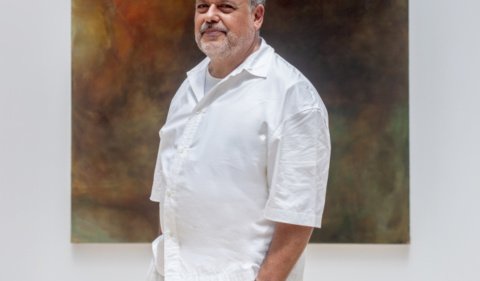Right now, you can pass the front window of Women & Their Work and immediately note Chandrika Metivier’s The Strike, a shiny Mylar-covered missile structure, bursting through a wall. It’s the opening statement for “Bending Light,” an exhibit showcasing four Texas-based artists as they explore the nuances in Black, queer, feminine experiences. Yes, it’s explosive – startling and violent. But that’s existence. “Bending Light” isn’t here to sugarcoat reality; it’s here to reflect the world. One might say it’s shining a light on societal injustices.
Curator Taylor Davis has championed local artists in the past, finding space for pop-ups or one-night performances, but this is the largest scale work she’s done. She traversed Texas (and the depths of Instagram) to find works that spoke in harmony. What emerged is a multimedia feast – steelworking sculptor Cat Martinez, collagist Kaima Marie Akarue, and video/sculpture artists Ciara Elle Bryant and the aforementioned Metivier.
There was no initial thesis statement for the show, but the pieces revealed threads. Especially once the artists started working within the gallery space. Davis told me she “let the artists lead the conversation,” and what arose were statements of persevering resistance.
The exhibit title arose from Martinez’s Ode to Marfa, a series of found objects encased in steel and colored Plexiglas. The Plexiglas creates a glow around fragments of tools and stone. Davis’ initial thoughts of diffraction suddenly softened in the face of the work. Marfa showed that light wasn’t shattered, it was curving around what’s already there. It was finding a path forward, regardless of the barrier.
That, more than anything else, is the perfect lens while viewing these pieces. Yes, it’s light working through, but in ways that contrast hardened materials with malleability. Feminine revolution against the cruel, hard world.
“Bending Light” isn’t here to sugarcoat reality; it’s here to reflect the world.
Martinez carries that torch through her other two pieces – obviously in Untitled – Number 05, where snippets of fabric and wool are flanked with steel, but most intensely in Africatown: Generational Trauma. It’s a massive monolith of steel and glass, resting on salvaged debris from International Paper (a company sued by the residents of Africatown, Alabama, for the deadly environmental effects of local pollution). Dirt and detritus from Mobile, where the last ship carrying enslaved Africans landed in 1860, fills water tanks. Each tank gets less murky going up the figure, generations clearing the way for new growth.
Growth is a literal presence in the nature-soaked video work of Bryant’s [EYE-Ah]. It’s a projected video piece, surrounded by focused images of flora and Bryant herself vinyled on the wall. The video is manipulated, using blacklight and layering to make the colors and forms explosive. There are flashes of plants, barbed wire, eyes, and forms filtered through layers of neon colors. It’s flowers and flame, burning away expectations to reveal the natural Bryant. Even the companion piece [EYE-Ah]’jute, a freestanding chair crowned with baby’s breath, has nature capturing the trappings of captivity. It speaks to the beauty of obstinate survival.
Similar boldness is seen in the depth of Akarue’s giant collages. They look like dystopian lands, chopped-up visions of a recognizable but industrial world. Each has figures making their way through pieced-together landscapes. In particular, Are we there yet? literally shows subjects on a collaged subway, passengers brashly staring at the viewer. Are they actually there yet? Or are the snippets filling the background – clippings showing money and advertisements and vague police references – keeping them from reaching their destination?
To the side of Metivier’s missile is a video. It shows them in intense close-up, reciting an anguished litany of grief after losing a child. The script is from a Stephen Adly Guirgis play, The Last Days of Judas Iscariot. But the words themselves, the sorrow in them, is universal. “It could be any mother, anyone who has experienced loss,” says Metivier.
“Bending Light” displays these four artists’ increasingly specific stories. They’ve each picked a lane – personal redemption, global strife, fractured histories – and reflected that outward. But the underlying current is familiar. Anguish, anger, renewal. All of them show unquenchable strength. Welcome, and witness the resilience.
“Bending Light”
Through Aug. 24





